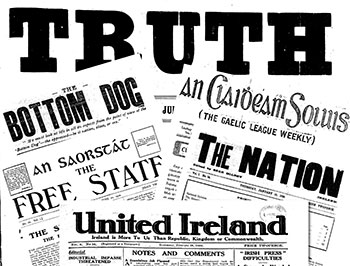New radical voices in the Irish Newspaper Archives
Published in Issue 6 (November/December 2019), News, Volume 27By Donal Fallon

Above: A selection of titles from the Irish Newspaper Archives’ Radical Newspapers Archive. Many of these publications have not been available on-line before, and they cover a broad sweep of nationalist, republican, feminist and socialist publications. (Irish Newspaper Archives)
The Irish Newspaper Archives has been a vital service for those researching the past for many years now, providing more than 300 years of archive publications on-line. Until now, these publications have consisted largely of national titles like the Freeman’s Journal, Irish Press and Irish Independent, as well as regional publications such as the Belfast News Letter and Dublin Evening Post.
The release of a special collection, in the form of the Radical Newspapers Archive, will be welcome news for many researchers, in particular those exploring the revolutionary period. More than 100 titles, many dating from the 1913–23 period, will be fully searchable within an on-line database. Many of these publications have not been available on-line before, and they cover a broad sweep of nationalist, republican, feminist and socialist publications.
Among the more familiar titles within the special collection is The Irish Worker, the primary organ of ‘Larkinism’ as the voice of the Irish Transport and General Workers’ Union. It has long been essential research material for anyone studying the Lockout and surrounding events. Less familiar labour publications in the special collection include The Toiler, an anti-Larkin publication from during the dispute. James Connolly’s The Workers’ Republic, its final edition printed on 22 April 1916, is also included in the new additions to the site.
The Irish Citizen, newspaper of the Irish Women’s Franchise League, has previously been available on-line in the British Newspaper Archive. Published between 1912 and 1920, the paper delighted in the election of Countess Markievicz in the 1918 election, telling readers that ‘Dublin leads in feminism and deserves congratulations as the only place that elected a woman candidate … Ireland proudly writes Progress on her banner and shows the world how much in advance she is of those who would rule her.’ The paper is notable for the strong anti-war position it took during the First World War, in stark contrast to much of the British suffrage movement. Its advertisements are in themselves interesting social history insights, as Dublin businesses sought to appeal to the pockets of suffragettes.
Throughout the fighting of the War of Independence, publications emerged and quickly vanished again, the authorities seeking to clamp down on dissent in the press wherever possible. The Republic first appeared on 21 June 1919, with its final edition published on 20 September 1919. Other papers were more successful; The Irish Bulletin (previously available in print thanks to the efforts of the Aubane Historical Society) was essentially the newspaper of Dáil Éireann, providing details of Dáil Courts as well as listing atrocities and reprisals. The War of Independence era newspapers capture not just the military dimensions of the conflict but also the surrounding social upheaval of the period. The Belfast Strike Bulletin, published during the January 1919 strikes that paralysed Ireland’s industrial capital, is an important publication that shows that militancy was not restricted to nationalists alone.
Together with the rich material on offer from the ever-expanding Military Archives website, these papers will form important research tools for those studying the conflict. The later Civil War is captured in publications like the Republican War News (10 August 1922 until 23 December 1922) and Freedom (29 August 1922 to 17 November 1922).
Post-independence papers from the 1920s and 1930s provide insights into those on the margins of Irish political life. An example of one such publication is the Irish Citizen Army Bulletin from 1934, published during attempts to re-establish the workers’ militia. The Republican Congress newspaper, the organ of the left-wing split from the IRA, which included Peadar O’Donnell and Frank Ryan in its ranks, is an important source, the paper detailing housing conditions in Ireland’s urban centres owing to the involvement of the Congress in tenants’ leagues and rent strikes. The publication is also notable for the involvement of celebrated artist Harry Kernoff, responsible for iconic cover illustrations of Roger Casement and James Connolly, as well as for the masthead. In the opposite corner of political life, The Blueshirts and United Irishman are digitised for the first time.
The Fianna Fáil Bulletin, published between 1935 and 1937, details the achievements and ideology of de Valera’s party in government, while the Labour Party is also represented in the new releases.
This collection of papers will benefit all those researching not only the revolutionary period but also the contested political landscape that emerged in its aftermath, and represents the most significant additions to the Irish Newspaper Archives since its launch. It is a reminder, too, that some of the most significant publications of twentieth-century Irish publishing (tabloids in particular, including the Sunday World) await digitisation.
Donal Fallon lectures on the Irish Revolution with UCD Lifelong Learning.
















